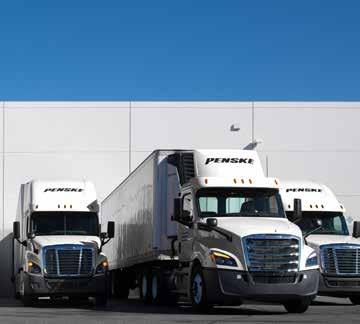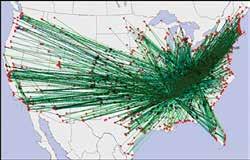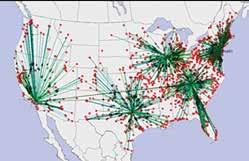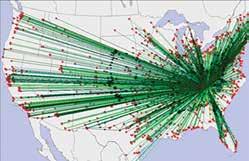
SUCCESS BY DESIGN
Unlocking the Strategic Power of Supply Chain Network Design


Unlocking the Strategic Power of Supply Chain Network Design
Supply chain network design is the process of determining the physical configuration and infrastructure of a supply chain. It is a powerful, strategic tool that executives can use to optimize a supply chain’s functionality. It has become vitally important to competitiveness as markets increase in both complexity and uncertainty.
In an increasingly uncertain world, network design is quickly becoming the new imperative. It is not only the pace of change driving network design’s value, it is also the scale of the changes that companies now face. The importance of strong network design strategy, planning and resiliency continues to be strongly felt across the globe as supply chains struggle to keep up with the changing complexity imposed by COVID-19.
Executives can leverage advanced 3PL’s logistics engineering and network design expertise to help scenario plan, validate strategic decisions, uncover cost savings, improve service levels, or integrate disparate networks following a merger or acquisition. Network design analysis can help inform critical decisions such as:
• The optimal number and location of plants and warehouses.
• The best mix of transportation modes and routes.
• Which customer fulfillment strategy to adopt when preparing for e-commerce.
• Evaluating supply chain strategies such as localization, offshoring or nearshoring.


Supply chain strategies change for myriad reasons, including preparing for growth, entering a new market, or changes in demand. Perhaps a company wants to plan for disruptive change and mitigate risk. For example, a manufacturer that wants to know how its business would be impacted if the plant was unexpectedly disabled.
Supply chain networks are often re-evaluated in response to a change in the organization or environment, such as:
• Mergers, acquisitions/divestitures.
• Facility lease agreements nearing the end of a term.
• Moving, opening or closing a distribution center.
• Changes in suppliers, supplier locations, or customers.
• Carrier changes.
• Responding to market shifts such as the imposition of higher tariffs or the emergence of a new competitor.
• New product launches or new product distribution channels such as e-commerce.
Regardless of the reason, when a review of a supply chain network is called for, executives often turn to network design to provide the insights and decision-making support they need to validate
their strategies. And many complex organizations will conduct a routine refresh annually to review their network proactively.
Supply chain network design (SCND) has long been a vital strategic tool, but its importance has grown markedly over recent years.
The ever-increasing need to lower costs and raise service levels is one reason for the rise of network design. Competitive supply chain network designs can add millions to the bottom line. Our research has shown that approximately 80% of supply chain costs are related to network design decisions. A good design initiative can achieve as much as 10% to 15% in supply chain cost savings.
Another driver is the dynamism of today’s competitive environment. As the pace of change has increased, so has the value of adaptive, flexible supply chains. Whether it is the inexorable growth of e-commerce or the uncertainties of a trade war, companies need network design to help them rapidly retune their supply chain networks to fast-changing market demands.
A corollary of this volatility is growing complexity. Network design is playing an increasingly critical role in helping decision-makers interpret and manage supply chain complexity.
Supply chain network design can add millions of dollars of cost savings annually, and as such, many executives value network design and consider it a top priority. Yet network design is not without its challenges, the most common of which are software and data, internal resources, and an effective process, so it’s vital that companies work with thirdparty logistics experts who have deep experience with execution as well as design.
Investing in the appropriate software is only the starting point – it takes much more to capture maximum competitive advantage from network design.
The initial investment is not trivial, and there are ongoing costs such as software licensing and annual fees. Additionally, for a more robust view of

the network, it is common to use multiple analysis platforms to run data and model scenarios. Penske Logistics utilizes several industry-leading tools as well as its proprietary software for analysis, modeling and optimization scenarios.
The technology challenge also goes beyond software upgrades. Another common issue is a lack of the robust, clean data that network design engines need to perform at the highest levels. In a survey of more than 500 senior business managers and executives, nearly 85% acknowledged that their companies are not good at capturing, processing, and integrating data streams from multiple sources. Penske Logistics’ dedicated team is experienced in sorting through and cleansing data to solve highlevel problems.
= 50 senior business managers and executives of senior business managers and executives said that their companies are not good at utilizing data streams 85%
Another critical factor to consider is the level of expertise required to capture maximum value from this resource. A tool is only as good as the proficiency of its user – especially one with the strategic horsepower of network design.




In addition to model-building and analytical know-how, network design teams need deep supply chain expertise to ensure that the models address and answer the right questions. Translating these answers into efficient supply chain networks that meet the specified objectives also requires in-depth operational knowledge and experience.
If a lack of internal resources is stalling network design efforts, a 3PL can be a useful resource to jump-start this initiative.
Last but by no means least, even the most comprehensive network design process is short-changed if only used periodically; when there is a crisis or a review is long overdue, for example. Analyses of supply chain network designs should be part of a cohesive, thoughtful supply chain strategy and performed regularly. Of course, that does not preclude network design being brought into play in response to some urgent need.
Beyond trigger events, Penske Logistics often helps companies with a routine refresh every year. By frequently reviewing the network, companies can create a living model in the design software and run regular analyses to see if things should change.
The case for deploying network design as a strategic resource has never been stronger, and executives who employ this tool can gain valuable insights to make better decisions and execute them more quickly. In many cases, the importance of a partner can help mitigate these issues and accelerate the timeline.
There are three ways to harness the power of network design: invest in an in-house resource, outsource a portion of your network design to a third-party provider or completely outsource your network design needs.
Some large companies with complex supply chains, as well as the financial and human resources required to support an internal team, choose the in-house route.
However, outsourcing to an outside expert, such as a leading third-party logistics provider (3PL) like Penske Logistics, offers several advantages.
• Avoids the upfront and ongoing costs associated with the in-house option.
• Provides instant access to the expertise and logistics resources required to fully exploit the potential of network design.
• Delivers instant access to the latest technological toolbox. For example, Penske uses LLamasoft and Blue Yonder best-in-class software to address strategic issues, as well as specialized proprietary tools to analyze facility locations and high-level network flow models. Modules for tactical components such as transportation modeling and a network analyzer for quickly identifying savings opportunities are also part of the toolbox.
• Brings a track record of implementing network solutions across multiple industries. Experience is critically important because the services of a market-leading 3PL extend beyond consultancy. Penske has the depth of expertise gained from building and operating supply chain networks and their many moving parts. This experience enables the 3PL to implement and continuously improve SCND solutions on behalf of shipper clients.
• Offers operational feasibility. Penske Logistics operates within hundreds of locations with expertise in the real world to know what it takes to evaluate the details of the network and apply actionable recommendations.
In an increasingly uncertain world, the strategic worth of network design will continue to rise. It is not only the pace of change driving network design’s value, it is also the scale of the changes that companies now face.
The most obvious example is the COVID-19 pandemic. The crisis has upended supply chain design in ways that will be felt for years to come. For example, critical shortages of medical equipment have strengthened the case for reducing reliance on global and regional supplier networks through localization.
Reconfiguring supply chains in this way requires robust modeling. Moreover, having localized a supply chain, companies may need to closely monitor their performance as the pandemic – and a host of other influences such as governmental policies –reshapes market conditions.
Thoughtful network design is no longer merely a desirable item on companies’ analytical wish lists – it is fast becoming an essential strategic tool.
The best network design programs are rooted in real-world problems with actionable solutions. Here are three examples from Penske’s portfolio of projects that illustrate how network design yields strategic value.
Challenge: A food packaging company wanted to evaluate and rationalize its outbound distribution network with leases on the company’s distribution centers (DCs) expiring in two years. Each plant had its own DC, and the manufacturer believed that it could reduce stock transfer moves, reduce distribution costs, and improve customer service by implementing mixing centers.
Solution: Penske Logistics conducted a study that looked at the optimization of transportation and warehousing for future demand and potential acquisitions.
Outcome: The study uncovered an 11% cost-saving opportunity by implementing one mixing center and improving transportation planning.
Challenge: After an acquisition, a food products manufacturer needed to understand supply chain synergies and optimize finished goods’ product flows between manufacturing plants to customer locations.
Solution: Penske Logistics analyzed transportation and warehousing resources of both companies to determine the number and locations of distribution centers.
Outcome: The analysis revealed that the company should keep two distinct supply chains, but with modifications. They should open another manufacturing plant, close three existing DCs and open a new DC in a more central location, which would result in an estimated savings of 7% to 14%.
Challenge: A large appliance manufacturer wanted to identify potential transportation savings through optimization of the company’s Midwest regional network, taking into account all transportation moves between inbound and outbound business units for both fleet and common carriers. The designs needed to balance the volumes handled by various carriers, lower the number of empty miles, and create routes that maximized trailer capacity.
Solution: Penske Logistics created inbound and outbound integrated network designs for the fleet and common carriers using its proprietary ClearChain® technology suite.
Outcome: The analysis identified transportation cost savings of 10% annually, increased load utilization, and reduced overall miles covered by 12%.
ò Establish your goals. What do you want to accomplish, such as reduced landed cost or improved service levels?
ò Define your timeline. When does the new network need to be implemented? (Typical engagements take 12-16 weeks with Penske Logistics and can take longer when insourced.)
• Are facility leases up?
• New product introduction.
• Impending supply changes.
ò Determine your process. How often will you evaluate your network – one time, yearly, etc.?
ò Define measures of success. Do you know your baseline and best-in-class measures for your industry, such as inventory levels or OTIF rate?
ò Prepare for change management. Will you be able to ensure the right incentives are in place?
ò Choose your method. Will you use in-house resources or fully or partially outsource to a consultant or 3PL?
If you choose to insource, the following are crucial to the success of your project:
ò Technology. Do you have, or do you need to acquire, the software and tools to do the job?
ò Data collection. Is your data clean and complete? (Without this you will run the risk of long timelines and poor results.)
ò Workforce and resources.
• Do you have full-time dedicated network design analysts and project management? (Usually 2-3 people required)
• Can IT support the data and software requirements?
• Do you have financial support for software/licensing investment as well as to confirm findings?
Using the visualization capabilities built into Penske’s proprietary ClearChain technology suite can bring the ideas associated with warehouse/ transportation cost trade-offs to life. This case study helps illustrate the importance of graphic-based modeling.
Multiple scenarios were considered ($ in cost/month)



